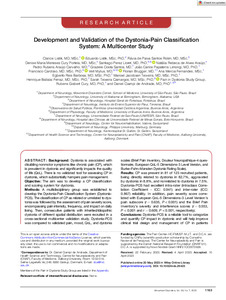Por favor, use este identificador para citar o enlazar este ítem:
https://repositorio.uca.edu.ar/handle/123456789/17343| Título: | Development and validation of the dystonia-pain classification System : a multicenter study | Autor: | Listik, Clarice Listik, Eduardo Santos Rolim, Flavia de Paiva Cury Portela, Denise Maria Meneses Pérez Lloret, Santiago Araújo, Natalia Rebeca de Alves Carvalho, Pedro Rubens Araújo Santos, Graziele Costa Limongi, João Carlos Papaterra Cardoso, Francisco Mylius, Veit Brugger, Florian Mercia Fernandes, Ana Barbosa, Egberto R. Teixeira, Manoel J. Ferraz, Henrique Ballalai Camargos, Sarah Teixeira Gisbert Cury, Rubens Ciampi de Andrade, Daniel |
Palabras clave: | DOLOR; DISTONÍA; TRASTORNOS DEL MOVIMIENTO; SINTOMAS NO MOTORES | Fecha de publicación: | 2023 | Editorial: | Wiley | Cita: | Listik, C., Listik, E., Santos Rolim, F. de Paiva, et al. Development and validation of the dystonia-pain classification System : a multicenter study [en línea]. Movement Disorders. 2023, 38(7). doi: 10.1002/mds.29423 . Disponible en: https://repositorio.uca.edu.ar/handle/123456789/17343 | Resumen: | Abstract: Background: Dystonia is associated with disabling nonmotor symptoms like chronic pain (CP), which is prevalent in dystonia and significantly impacts the quality of life (QoL). There is no validated tool for assessing CP in dystonia, which substantially hampers pain management. Objective: The aim was to develop a CP classification and scoring system for dystonia. Methods: A multidisciplinary group was established to develop the Dystonia-Pain Classification System (Dystonia- PCS). The classification of CP as related or unrelated to dystonia was followed by the assessment of pain severity score, encompassing pain intensity, frequency, and impact on daily living. Then, consecutive patients with inherited/idiopathic dystonia of different spatial distribution were recruited in a cross-sectional multicenter validation study. Dystonia-PCS was compared to validated pain, mood, QoL, and dystonia scales (Brief Pain Inventory, Douleur Neuropathique-4 questionnaire, European QoL-5 Dimensions-3 Level Version, and Burke–Fahn–Marsden Dystonia Rating Scale). Results: CP was present in 81 of 123 recruited patients, being directly related to dystonia in 82.7%, aggravated by dystonia in 8.8%, and nonrelated to dystonia in 7.5%. affected by this disorder. © 2023 The Authors. Movement Disorders published by Wiley Periodicals LLC on behalf of International Parkinson and Movement Disorder Society. Dystonia-PCS had excellent intra-rater (Intraclass Correlation Coefficient - ICC: 0.941) and inter-rater (ICC: 0.867) reliability. In addition, pain severity score correlated with European QoL-5 Dimensions-3 Level Version’s pain subscore (r = 0.635, P < 0.001) and the Brief Pain Inventory’s severity and interference scores (r = 0.553, P < 0.001 and r = 0.609, P < 0.001, respectively). Conclusions: Dystonia-PCS is a reliable tool to categorize and quantify CP impact in dystonia and will help improve clinical trial design and management of CP in patients affected by this disorder. | URI: | https://repositorio.uca.edu.ar/handle/123456789/17343 | ISSN: | 1531-8257 (online) 0885-3185 (impreso) |
Disciplina: | MEDICINA | DOI: | 10.1002/mds.29423 | Derechos: | Acceso abierto | Fuente: | Movement Disorders. 2023, 38(7) |
| Aparece en las colecciones: | Artículos |
Ficheros en este ítem:
| Fichero | Descripción | Tamaño | Formato | |
|---|---|---|---|---|
| development-validation-dystonia.pdf | 436,38 kB | Adobe PDF |  Visualizar/Abrir |
Visualizaciones de página(s)
32
comprobado en 27-abr-2024
Descarga(s)
16
comprobado en 27-abr-2024
Google ScholarTM
Ver en Google Scholar
Altmetric
Altmetric
Este ítem está sujeto a una Licencia Creative Commons

